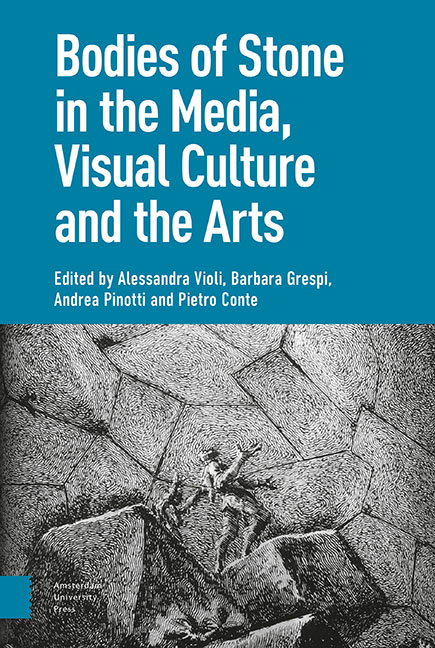Book contents
- Frontmatter
- Contents
- Introduction: Learning from Stone
- I Statue: The Imaginary of Uncertain Petrification
- 1 Theatre and Memory: The Body-as-Statue in Early Modern Culture
- 2 Translated Bodies: A ‘Cartographic’ Approach
- 3 Pantomime in Stone: Performance of the Pose and Animal Camouflage
- 4 Animated Statues and Petrified Bodies: A Journey Inside Fantasy Cinema
- 5 The Ephemeral Cathedral: Bodies of Stone and Configurations of Film
- II Matter: Size, Hardness, Duration
- 1 Bodies That Matter: Miniaturisation and the Origin(s) of ‘Art’
- 2 Brancusi’s ‘Sculpture for the Blind’
- 3 Cinema, Phenomenology and Hyperrealism
- 4 Ephemeral Bodies: The ‘Candles’ of Urs Fischer
- 5 The Celluloid and the Death Mask: Bazin’s and Eisenstein’s Image Anthropology
- III Corpse: Fossils, Auto-Icons, Revenants
- 1 Funeral Eulogy: Post-Mortem Figures and Redeemed Bodies, in Images
- 2 On Jack Torrance As a Fossil Form
- 3 Technical Images and the Transformation of Matter in Eighteenth-Century Tuscany
- 4 Glass, Mixed Media, Stone: The Bodily Stuffs of Suspended Animation
- 5 Bodies’ Strange Stories: Les Revenants and The Leftovers
- IV Monument: Embodying and Grafting
- 1 The Impassibly Fleshly, the Statue of the Impossible
- 2 Frozen into Allegory: Cleopatra’s Cultural Survival
- 3 The Orphan Image
- 4 The Well-Tempered Memorial: Abstraction, Anthropomorphism, Embodiment
- 5 Monuments of the Heart: Living Tombs and Organic Memories in Contemporary Culture
- Index
III - Corpse: Fossils, Auto-Icons, Revenants
Published online by Cambridge University Press: 20 November 2020
- Frontmatter
- Contents
- Introduction: Learning from Stone
- I Statue: The Imaginary of Uncertain Petrification
- 1 Theatre and Memory: The Body-as-Statue in Early Modern Culture
- 2 Translated Bodies: A ‘Cartographic’ Approach
- 3 Pantomime in Stone: Performance of the Pose and Animal Camouflage
- 4 Animated Statues and Petrified Bodies: A Journey Inside Fantasy Cinema
- 5 The Ephemeral Cathedral: Bodies of Stone and Configurations of Film
- II Matter: Size, Hardness, Duration
- 1 Bodies That Matter: Miniaturisation and the Origin(s) of ‘Art’
- 2 Brancusi’s ‘Sculpture for the Blind’
- 3 Cinema, Phenomenology and Hyperrealism
- 4 Ephemeral Bodies: The ‘Candles’ of Urs Fischer
- 5 The Celluloid and the Death Mask: Bazin’s and Eisenstein’s Image Anthropology
- III Corpse: Fossils, Auto-Icons, Revenants
- 1 Funeral Eulogy: Post-Mortem Figures and Redeemed Bodies, in Images
- 2 On Jack Torrance As a Fossil Form
- 3 Technical Images and the Transformation of Matter in Eighteenth-Century Tuscany
- 4 Glass, Mixed Media, Stone: The Bodily Stuffs of Suspended Animation
- 5 Bodies’ Strange Stories: Les Revenants and The Leftovers
- IV Monument: Embodying and Grafting
- 1 The Impassibly Fleshly, the Statue of the Impossible
- 2 Frozen into Allegory: Cleopatra’s Cultural Survival
- 3 The Orphan Image
- 4 The Well-Tempered Memorial: Abstraction, Anthropomorphism, Embodiment
- 5 Monuments of the Heart: Living Tombs and Organic Memories in Contemporary Culture
- Index
Summary
The techniques of producing death masks and mummies point back to the petrified cadaver as a primordial image. The corpse is a body that turns into a thing and into an image (made) of itself. The essays in this section cluster around this aspect of the dead body's materiality and explore its multifarious afterlives focusing on the entanglement among technical images, natural images and the emerging life sciences of the modern period, from biology to chemistry to geology. Starting with the eighteenth century, modern science was fascinated by the states of life-in-death revealed by ostensibly inert matter, be they fossils, crystals or the natural moulds that grow out of volcanoes. As the movement of life in nature was increasingly recognised to permeate ever deeper time and organic structures, the question arose: is the still, mineralised body actually dead? Or are fossils and stones in states of latent life, suspended animation? And how reversible are these processes of transformation?
The attempt to emulate natural images and processes by chemical and technical means spurred a modern imaginary of living corpses: far from indicating the extinction of the living, petrification seemed to offer a technique for an indefinite extension of life, a living-on that incorporated death in life. Despite the variety of the media involved, this imaginary runs through the photographic plate's capacity to fix and freeze moving beings, the lithic iconography of modern anatomical atlases, the life of organic fossils that survive through material changes, or bodies embalmed as petrified auto-icons. What we see emerging at this historic juncture are the often-unacknowledged forerunners of our contemporary obsession with the animation of things and the deanimation of human bodies. In this light, all the authors here foreground patterns of continuity among the archaic, the modern and the contemporary, and their essays are ultimately also about cultural living corpses, showing how theories that have seemingly expired can take on a new lease of life.
Farinotti's piece begins the section by approaching the ontology of photography from the theoretical standpoint of Blanchot, Barthes and Dubois, whose thanatological perspectives on the medium are woven into a single narrative of the photographic image as ‘death at work’.
- Type
- Chapter
- Information
- Bodies of Stone in the Media, Visual Culture and the Arts , pp. 205 - 210Publisher: Amsterdam University PressPrint publication year: 2020

